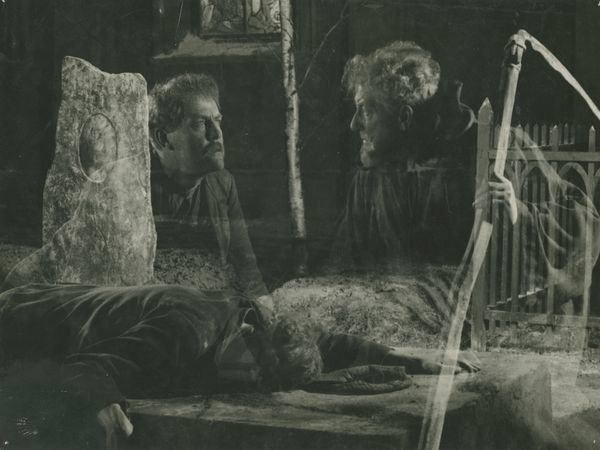KÖRKARLEN
(The Phantom Carriage)
Victor Sjöström (SE 1921)
Victor Sjöström’s Körkarlen (The Phantom Carriage), arguably the most canonical of all Swedish silent films, is based on a short novel by Selma Lagerlöf, whose writings provided such a rich source of stories for the Swedish cinema at the time. Sjöström wrote the script in one week, and in April 1920 he submitted it to Lagerlöf and made some minor changes according to her wishes. Shooting began in May and lasted until July. Körkarlen was the first film to be shot in AB Svensk Filmindustri’s newly erected facilities in Råsunda, north of Stockholm. Sjöström and cinematographer Julius Jaenzon had all the shooting and laboratory facilities they needed for this, their 15th film together. Because it had a lengthy post-production, Körkarlen was not the first film shot in the new studios to be released (that was Stiller’s Erotikon), and Sjöström himself even shot and saw the release of Mästerman before Körkarlen finally opened, on New Year’s Day 1921 – a most appropriate date for a film in which Sylvester Night (New Year’s Eve) plays such an important part.
Widely known and frequently seen, Körkarlen is indeed a film which rewards multiple viewings; each time one can only marvel at the ease and clarity with which the complex narrative structure, with its multi-layered temporality, unfolds. The intriguing use of multiple exposures was achieved by cinematographer Julius Jaenzon in the camera, sometimes exposing the same piece of film no less than four times in order to create images where the living and the dead, and the “spiritual” and the “real” world, exist side by side. The film received rave reviews and was very successful at the box-office, not only in Sweden but abroad, including a now-legendary British trade show, opening at the London Alhambra in February 1921. In Sweden, the film was also widely seen through alternative distribution channels: the popular movement for the abolition of drinking screened the film in campaigns starting in 1922, and it was also distributed in schools and through the Salvation Army.
The complex structure and impressive technical execution notwithstanding, Körkarlen remains a rich psychological drama. Its study of human relationships, and how they are shaped by external circumstances, self-sacrificing love, and fear of God, is further enhanced by the remarkable acting, not least by that of Hilda Borgström and Sjöström himself, here demonstrating that he was a major figure in silent cinema in front of, as well as behind, the camera. The film has influenced a number of filmmakers. Acknowledging his debt to Sjöström and Körkarlen, in 1957 Ingmar Bergman used the same Råsunda studios to shoot parts of his film Smultronstället (Wild Strawberries), in which Sjöström – in his final performance – once again portrays a man looking back on his life, and the pain and injustice he inflicted upon others.
The print: Körkarlen has been preserved using two different sources: a shortened Swedish black & white re-release print from the late 1920s, and a tinted nitrate American distribution print. The intertitles have been recreated from the titles in the Swedish print and original title cards in the collections of the Swedish Film Institute. The print was struck in 2003.
Jon Wengström

regia/dir: Victor Sjöström.
scen: Victor Sjöström; dal romanzo di/based on the short novel by Selma Lagerlöf (1912).
photog: J. Julius [Julius Jaenzon].
scg/des: Axel Esbensen, Alexander Bakó.
cast: Victor Sjöström (David Holm), Hilda Borgström (Anna, sua moglie/Anna, his wife), Astrid Holm (Edit, la sorella dell’Esercito della Salvezza/Edit, Salvation Army sister), Tore Svennberg (l’amico di David, il conducente del calesse/David’s friend, driver of the carriage), Concordia Selander (la madre di Edit/Edit’s mother), Einar Axelsson (il fratello di David/David’s brother), Lisa Lundholm (Maria, sorella dell’Esercito della Salvezza/Maria, Salvation Army sister), Olof Ås (primo conducente del calesse/first driver of the carriage).
prod: AB Svenska Biografteatern.
riprese/filmed: 1920.
copia/copy: 35mm, 1937 m., 106′ (16 fps), col. (imbibito/tinted, procedimento Desmet/Desmet process); did./titles: SWE.
fonte/source: Svenska Filminstitutet, Stockholm.


 Italiano
Italiano